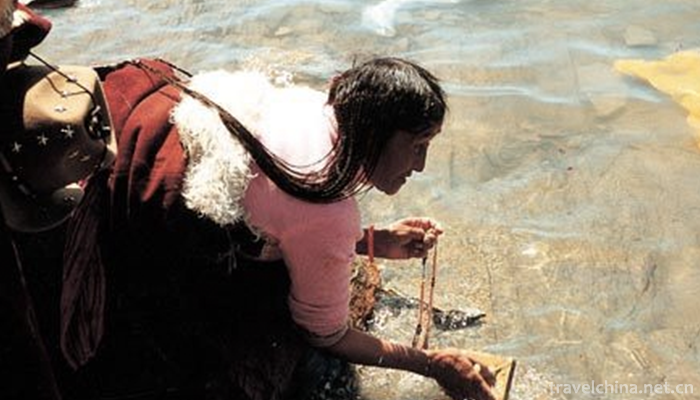Qinghai Lake offering sacrifices to the sea
Qinghai Lake offering sacrifices to the sea
Qinghai Lake is a pearl on the plateau of the mangyang snow area, which has been admired by people for thousands of years. This paper systematically expounds the origin, course, ritual rules and contemporary evolution of the sacrifice to the sea in Qinghai Lake, and tries to explore the historical evolution of the phenomenon of sacrifice to the sea. Qinghai Lake offering sacrifices to the sea is not only a folk custom activity with strong religious color, but also a cultural phenomenon, which contains many folk customs, and also expresses people's desire for harmonious coexistence with nature.
On June 14, 2008, the Qinghai Lake Sacrifice to the Sea declared by Haibei of Qinghai Province was approved by the State Council to be included in the second batch of national intangible cultural heritage list (category: folklore; number: _-86).
historical origin
The activities of offering sacrifices to the sea originated in Yongzheng period. In the second year of Yongzheng, General Nian Xiyao led the army to calm the rebellion of Qinghai Mongol leader Rob Zangdanjin, and to pursue the rebels to Qinghai Lake, the army began to run short of drinking water. At this time, a group of cavalry horses came from a distance. Several horses'hooves were stepping on the ground. The fresh water gushing out immediately solved the problem of drinking water for the army. The morale-boosting officers and men united to wipe out the rebels. After the Emperor Yongzheng heard about it, the imperial edict sealed the "Spiritual Revelation of Qinghai Lake", emperor granted the throne, placed it in the sea temple of Qinghai, and ordered regular sea worship in August every year (July 15 of the lunar calendar). Since then, large-scale sea worship activities began.
The sacrifice to the sea is the sacrifice to Qinghai Lake, which was originally a Mongolian tradition. Originally, the Mongolians who believed in Shamanism believed that all things were spiritual, especially that heaven was the Supreme god. In the Yuan Dynasty, the Mongolian people had the custom of offering sacrifices to heaven, mountains and seas. Since the Qing Dynasty, the sacrificial activities of Qinghai Lake have become more large-scale and religious. At the same time, Tibetans around the lake also took part in the sacrificial ceremony.
Nowadays, the ceremony of offering sacrifices to the sea in Qinghai Lake has been totally Tibetan. For Tibetan compatriots, offering sacrifices to the sea in Qinghai Lake is a very sacred thing, just like turning the year of horse into the sacred mountain and the year of sheep into the sacred lake. And large-scale sea worship ceremony once or twice a year, if you can catch up with the sea worship ceremony presided over by the eight living Buddhas on the edge of Qinghai Lake, that is the lucky life of Sansheng.
Activity content
Aquarius is one of the eight treasures in Tibet and an indispensable sacrificial object in the ceremony of offering sacrifices to the sea. The vase contains barley, wheat, pea, corn and broad beans. Coral, honeywax, agate and other grains are ground into flour and mixed into the vase. Finally, the vase is put into the Jingpai, which is then tied by the Living Buddha. In the ceremony of offering sacrifices to the sea, the people put the vase bearing their wishes into Qinghai Lake to pray for the realization of their wishes.
Along the 999-meter-long wooden trestle road to the sacrificial platform, more and more Tibetans are holding vases made of cereals in their hands. They stood on the altar, rounded their arms, threw the vase into the Qinghai Lake, and sent out their wishes.
In the rippling Qinghai Lake, ecological treasure bottles float on the water, which not only allows Tibetan people to pray for national security, the prosperity of human and animal, and the prosperity of grain, but also is their intention to protect Shenhu Lake.
Inheritance Significance
In 2008, it was selected as the second batch of national intangible cultural heritage list approved by the Ministry of Culture by the State Council. Qinghai Lake is the "holy lake" in the hearts of the Tibetan people living here. Every year, the local Tibetan people come to the lake in groups to "sacrifice to the sea" in their own way, in order to pray for national peace, prosperity of people and livestock, and prosperity of grain.


-
1.Mandarin Oriental Hotel Guangzhou
Wenhua Oriental Hotel is located in Tianhe District of Guangzhou, which belongs to Wenhua Oriental Hotel Group. It is a five-star hotel. The hotel has 233 rooms and 30 suites, and 24 hotel-style servi
Time 2018-12-16 -
2.Harbin Polarland
Harbin Polar Museum is the world's first polar entertainment park, one of the four major scenic spots of Harbin International Ice and Snow Festival, the national 4A-level tourist attraction
Time 2019-01-13 -
3.Helan Mountain Rock Painting
Helan Mountain Rock Painting is a national key cultural relics protection unit, the national AAAA level tourist attractions, the national research tourism demonstration base (2016 one of the first 20)
Time 2019-01-13 -
4.Mawei Shipping Museum
The Mawei Shipbuilding Cultural Heritage Group in Fuzhou is centered on the Chinese Shipbuilding Cultural Museum, including Zhongpo Battery, Zhaozhong Temple, British Consulate
Time 2019-02-06 -
5.Quancheng Marine Polar World
Quancheng Marine Polar World is a comprehensive exhibition hall located in Qihe County, Dezhou City, Shandong Province, with a total investment of 1 billion yuan
Time 2019-02-07 -
6.Zhijin cave
Zhijin Cave, located in Guanzhai Miao Township, Zhijin County, Guizhou Province, is located on the South Bank of Liuchong River, one of the sources of Wujiang River, 120 kilometers away from Guiyang,
Time 2019-03-18 -
7.Wind and Fire Meteor
Fenghuo Meteor is a traditional folk performing art which combines acrobatics and martial arts. It is one of the first intangible cultural heritages in Shanxi Province.
Time 2019-04-29 -
8.Comba Rai
"Kangbalayi" is a poetic language of communication between Tibetan men and women in Zhiduo County. It originated in Songzan Period of Southern Japan in the end of the sixth century.
Time 2019-05-08 -
9.Saban Festival of the Tatar Nationality
The Saban Festival (also known as Ploughshare Festival) of the Tatar Nationality is a unique traditional festival of the Tatar Nationality. Every year, after the spring sowing of all the farmers in th
Time 2019-06-18 -
10.Sichuan Tourism University
Sichuan Tourism College is the first independent tourism undergraduate college in China. In 2018, it was approved by the Overseas Chinese Office of the State Council as the base of "Overseas Chin
Time 2019-08-31 -
11.Anhui Jianzhu University
Anhui Architecture University is a multi-disciplinary university characterized by the discipline of civil engineering. It is Anhui province. Ministry of housing and urban rural development To build th
Time 2019-10-10 -
12.Huangjing Nature Reserve
This entry is lack of overview map, supplement the relevant content to make the entry more complete, but also quickly upgrade, come on!
Time 2020-10-16